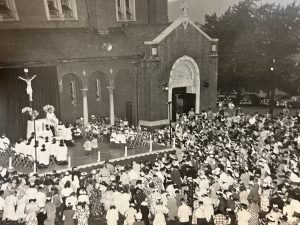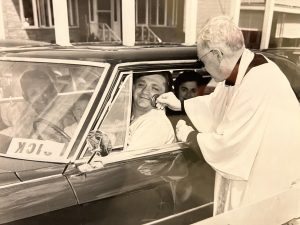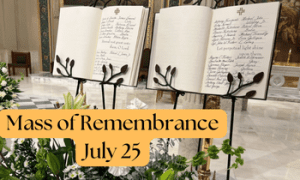
INDIANAPOLIS (OSV News) — “Sweet anointing, cleansing love, merciful healer, unending love.”
Tony Meléndez sang to his guitar, telling the audience gathered at Lucas Oil Stadium July 19 for the National Eucharistic Congress’ Encounter session that Jesus can heal them. And he was living proof.
The 62-year-old guitarist, who was born without arms and with a clubbed foot, talked about his life and how God used for his glory the differences that had caused his mother to cry for her baby after his birth. The seven surgeries that were required to correct his foot physically optimized his ability to play the guitar with his feet, he said. Meléndez showed a video of playing in 1987 for Pope St. John Paul II, who kissed him and told him to share his gift with the world. He has since played in 45 countries.
The third day of the national congress, held July 17-21 in Indianapolis, had as its theme “Into Gethsemane” — and it saw wide encouragement for congress-goers to experience healing in the Eucharist and then to bring Jesus’ healing to others.
“Healed people heal people,” Mary Healy, a Scripture professor at Detroit’s Sacred Heart Major Seminary, said. She spoke about Jesus’ healings in Scripture and shared powerful examples of people living today who have been healed of serious medical conditions through prayer.
What Jesus did 2,000 years ago “he is still doing now, today, and he wants us to know it, and he wants us to experience it,” she said, adding, “the Lord wants his church to be healed people, set free, made whole, so that we can go out and be his instruments of healing.”
The Cultivate impact session for families focused on healing through the sacraments.
“Healing is an ongoing encounter with God’s love that brings us into wholeness and communion,” Bob Schuchts, author and founder of the Tallahassee, Florida-based John Paul II Healing Center.
“Think about the little girl that Jesus brought back to life,” he said. “Think how joyful her parents were and how their faith in God might have been restored.”
He encouraged children to “believe everything in the Bible, including the healings.”
“Every time we receive Jesus in the Eucharist, we can say, ‘Jesus, heal this part of me that’s dead inside; this part that’s grieving; heal this relationship I have,’ and he answers those prayers,” Schuchts said. “If he’s really truly present, is there anything he can’t do now that he did back then?”
It might happen as a miracle, or it might happen over time — such as for Schuchts and his siblings decades after their parents’ divorce.
“When you lose the love in families, hearts get broken,” he said, adding it was only after returning to the sacraments that he and his family experienced healing and peace.
Before a crowd of about 5,000, Mari Pablo of Evangelical Catholic reflected on the difficulties of living out the faith and helping others to do so in ministry at the Renewal impact session.
“Being Catholic doesn’t mean that you don’t suffer or have struggles,” she said. “We’re the religion that has crucifixes everywhere. But the story doesn’t end there. He conquered death and the grave. I know suffering, pain, death and healing are hard. But we’re created for so much more. We’re created for heaven.”
At the Awake youth impact session, more than 1,000 teenagers raised their voices in song to God and heard a message of healing for their hearts.
“My soul needs a friend, so I’ll run to the Father,” they sang along to the popular Matt Maher worship song.
“You are here turning lives around. You are here healing every heart. I worship you. I worship you.”
Catholic motivational speaker Jackie Francois Angel, in her presentation, told the youth that God “loves us so deeply, but unfortunately so many of us don’t know how good we are. So many of us don’t think we’re good enough.”
“God’s love is unconditional. He proved his love for us. And while we are all sinners, Christ died for us. He doesn’t stop loving us when we do bad things. He loves us in spite of that,” Angel said. “He loves all of us because he created us. We don’t earn God’s love, which also means we can’t lose God’s love. God’s love is unconditional.”
The clergy Abide impact session continued with a focus on forming men and women as Eucharistic missionaries and laying the groundwork for them to bear fruit as evangelizers in an increasingly secularized culture. Pastors were encouraged to build a culture in their parishes and dioceses in which the families in their flocks can be formed and equipped to live and share the Gospel in a new “apostolic age.”
Nearly 2,000 Latino Catholics joined the morning Mass in Spanish attended by Philadelphia Archbishop Nelson J. Pérez, and then heard the Archbishop Gustavo García-Siller of San Antonio preach on how the Eucharist, as Christ’s medicine, heals “our inability to love” and gives us hope.
“Through our full, conscious and active participation in the Eucharistic celebration, we are transformed in God’s love,” he said, and we are “empowered to practice the corporal and spiritual works of mercy, which are, as Pope Francis reminds us, the protocol on which we will be judged.”
Thousands of Catholics gathered in Lucas Oil Stadium at the early morning Mass in English heard Cardinal Wilton D. Gregory of Washington reflect on St. John’s words: “God is light and in him there is no darkness at all.”
He reflected that while theologians and scholars have focused on Christ’s presence in the Eucharist historically, it is often “the uncomplicated faith of ordinary people that serves as an assurance of the wonder of this gift.”
He emphasized that believing in Jesus’s real presence in the Eucharist “must also prompt our equally important active response to that presence in charity, in each of our lives offered in
service and with care for others.”
Congress-goers that day had an opportunity to live out “the determined pursuit of social justice and the genuine compassionate outreach toward the poor and the neglected” Cardinal Gregory said comes from a belief in the Real Presence, by joining in packing several hundred thousand meals that afternoon for Indianapolis’ people suffering from hunger and homelessness. Many participants walking around the surrounding area of the congress could see people in poverty sleeping under highways or asking for help to get a meal.
In fact, the day saw a powerful testimony to the power of belief in the Real Presence and radical commitment to the Gospel at the Empower session from Martha Hennessy, the granddaughter of Servant of God Dorothy Day.
Hennessy, who remains active in the Catholic Worker movement at the Maryhouse Catholic Worker community in New York City, said that her grandmother’s devotion to the Eucharist stays with the movement “as we continue to practice corporal and spiritual works of mercy as Jesus gave of himself to us.”
Hennessy noted her grandmother’s practice upon receiving the Eucharist in holy Communion was to remain silent for 20 minutes after “to allow herself to absorb the presence of God within her before returning to her work.”
She shared comments from Day about her devotion to the Eucharist, such as this one: “Scripture, on the one hand, and the Eucharist, the Word made flesh, on the other, have in them that strength which no power on Earth can withstand.”
Hennessy also shared Day’s reflection that “our need to worship, to praise, to give thanksgiving makes us return to the Mass daily. The Mass begins our day. It is our food, drink, our delight, our refreshment, our courage, our life.”
After the morning sessions concluded, the expo hall in the Indiana Convention Center was packed at lunchtime for a performance of the three-piece Dominican friar band, The Hillbilly Thomists. People sang, danced and clapped along to the friars’ much-anticipated performance, which had been delayed a day due to travel difficulties.
Philip and Melissa Smaldino, from Yorktown, Indiana, who are expecting their seventh child in October, watched the band from the sidelines along with their six little ones.
“My wife and I came back to Christ in the Catholic Church about 10 years ago, and Eucharistic adoration and confession were really important for that,” Philip Smaldino told OSV News. The couple said they especially enjoyed the periods of Eucharistic adoration, both at Lucas Oil Stadium in the evenings and also the “absolutely packed” family holy hour at St. John the Evangelist Church, where the children got to bring Christ flowers.
“Our hope is we grow in our faith and devotion to Christ and the Eucharist through it all,” he said. “Melissa and I, but especially the kids, too.”
At the midmorning press conference at the nearby Crowne Plaza Hotel, reporters learned that the mass disruption in flights due to a software glitch was not expected to impact attendance. With tens of thousands already participating in the congress, what congress organizers did note, however, was that many participants with one-day passes were now changing their registration for the full five-days after experiencing one day of the congress.
“I’ve been a priest 35 years, 12 years a bishop. And other than a papal visit … I don’t remember an event like this,” Archbishop Perez said.
“You can sense the energy, right?” he added. “You can sense the energy of what’s happening here, which is touching hearts.”













